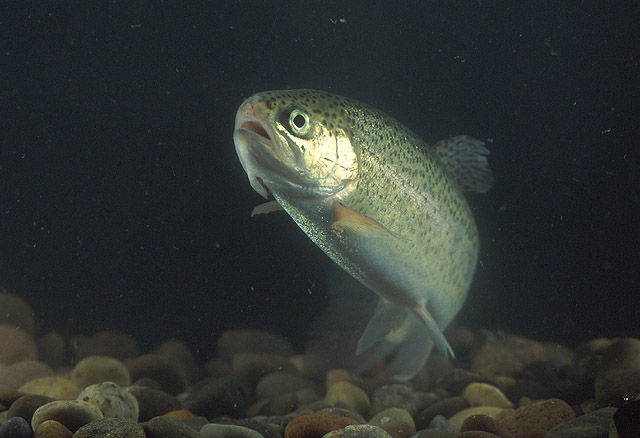Trout (Family: Salmonidae, Subfamily: Salmoninae) - Wiki Trout
From Wikipedia, the free encyclopedia
Order: Salmoniformes
Family: Salmonidae
Subfamily: Salmoninae
[Photo] Rainbow trout (Oncorhynchus mykiss). Photo by Ken Hammond. Image Number 95cs2028 (www.ars.usda.gov/is/graphics/photos/dec01/95cs2028.htm). License: public domain.
Trout is the common name given to a number of species of freshwater fish belonging to the salmon family, Salmonidae.
All fish called trout are members of the subfamily Salmoninae. The name is commonly used for species in three of the seven genera in the sub-family: Salmo, which includes Atlantic species; Oncorhynchus, which includes Pacific species; and Salvelinus, which includes fish also sometimes called char or charr. Fish referred to as trout include:
Genus Salmo
Adriatic trout, Salmo obtusirostris
Brown trout, Salmo trutta
Flathead trout, Salmo platycephalus
Marmorata, Soca River trout or So??a trout - Salmo trutta marmoratus
Ohrid trout, Salmo letnica
Sevan trout, Salmo ischchan
Genus Oncorhynchus
Apache trout, Oncorhynchus apache
Seema, Oncorhynchus masou
Cutthroat trout, Oncorhynchus clarki
Gila trout, Oncorhynchus gilae
Golden trout, Oncorhynchus aguabonita
Rainbow trout, Oncorhynchus mykiss
Mexican Golden Trout, Oncorhynchus chrysogaster and as many as eight other species or sub-species in northwest Mexico, not yet formally named.
Genus Salvelinus (Char)
Arctic char, Salvelinus alpinus
Aurora trout, Salvelinus fontinalis timagamiensis
Brook trout, Salvelinus fontinalis
Bull trout, Salvelinus confluentus
Dolly Varden trout, Salvelinus malma
Lake trout, Salvelinus namaycush
Silver trout, † Salvelinus fontinalis agassizi (extinct)
Trout are usually found in cool, clear streams and lakes, although many of the species have anadromous strains as well. They are distributed naturally throughout North America, northern Asia and Europe. Several species of trout were introduced to Australia and New Zealand by amateur fishing enthusiasts in the 19th century, effectively displacing and endangering several upland native fish species. The introduced species included brown trout from England and rainbow trout from California. The rainbow trout were a steelhead strain, generally accepted as coming from Sonoma Creek. The rainbow trout of New Zealand still show the steelhead tendency to run up rivers in winter to spawn.
Trout have fins entirely without spines, and all of them have a small adipose (fatty) fin along the back, near the tail. There are many species, and even more populations that are isolated from each other and morphologically different. However, since many of these distinct populations show no significant genetic differences, what may appear to be a large number of species is considered a much smaller number of distinct species by most ichthyologists.
The trout found in the eastern United States are a good example of this. The brook trout, the aurora trout, and the (extinct) silver trout all have physical characteristics and colourations that distinguish them, yet genetic analysis shows that they are one species, Salvelinus fontinalis.
Lake trout (Salvelinus namaycush), like brook trout, actually belong to the char genus. Lake trout inhabit many of the larger lakes in North America, and live much longer than rainbow trout, which have an average maximum lifespan of 7 years. Lake trout can live many decades, and can grow to more than 30 kg (66 pounds).
Trout generally feed on soft bodied aquatic invertebrates, such as flies, mayflies, caddisflies, stoneflies, and dragonflies. In lakes, various species of zooplankton often form a large part of the diet. In general, trout longer than about 30 cm prey almost exclusively on fish, where they are available. Adult trout will devour fish exceeding 1/3 their length.
As a group, trout are somewhat bony, but the flesh is generally considered to be tasty. Additionally, they provide a good fight when caught with a hook and line, and are sought after recreationally. Because of their popularity, trout are often raised on fish farms and planted into heavily fished waters, in an effort to mask the effects of overfishing. While they can be caught with a normal rod and reel, fly fishing is a distinctive method developed primarily for trout, and now extended to other species. Farmed trout and char are also sold commercially as food fish.
Trout that live in different environments can have dramatically different colorations and patterns. Mostly, these colors and patterns form as camouflage, based on the surroundings, and will change as the fish moves to different habitats. Trout in, or newly returned from the sea, can look very silvery, while the same "genetic" fish living in a small stream or in an alpine lake could have pronounced markings and more vivid coloration. It is virtually impossible to define a particular color pattern as belonging to a specific breed; however, in general, wild fish are claimed to have more vivid colors and patterns.
The cutthroat trout has 14 recognized subspecies (depending on your sources), such as the Lahontan cutthroat trout, Oncorhynchus clarki henshawi, Bonneville cutthroat trout, Oncorhynchus clarki utah, Colorado River cutthroat trout, Yellowstone cutthroat trout.
http://en.wikipedia.org/wiki/Trout
| The text in this page is based on the copyrighted Wikipedia article shown in above URL. It is used under the GNU Free Documentation License. You may redistribute it, verbatim or modified, providing that you comply with the terms of the GFDL. |
